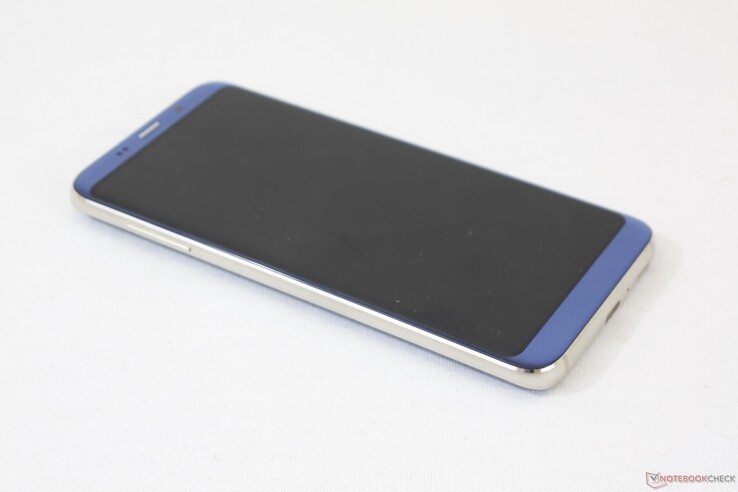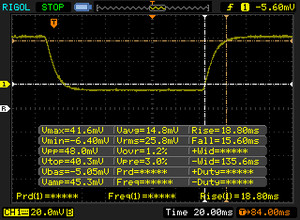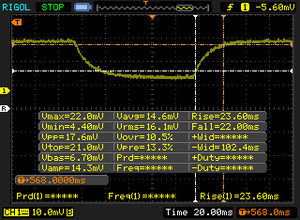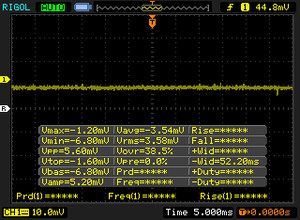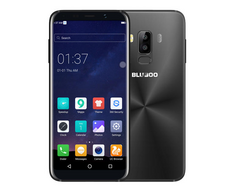Recensione breve dello Smartphone Bluboo S8
I nostri Top 10
» Top 10 Portatili Multimedia
» Top 10 Portatili Gaming
» Top 10 Portatili Gaming Leggeri
» Top 10 Portatili da Ufficio e Business economici
» Top 10 Portatili Premium da Ufficio/Business
» Top 10 Portatili sotto i 300 Euro
» Top 10 Portatili sotto i 500 Euro
» Top 10 dei Portatili Workstation
» Top 10 Subnotebooks
» Top 10 Ultrabooks
» Top 10 Convertibili
» Top 10 Tablets
» Top 10 Tablets Windows
» Top 10 Smartphones
| SD Card Reader | |
| maximum SDCardreader Maximum Transfer Rate | |
| average SDCardreader Average Transfer Rate |
| Networking | |
| iperf3 transmit AX12 | |
| Samsung Galaxy S8 | |
| Huawei Y7 | |
| Bluboo S8 | |
| iperf3 receive AX12 | |
| Samsung Galaxy S8 | |
| Huawei Y7 | |
| Bluboo S8 | |
| |||||||||||||||||||||||||
Distribuzione della luminosità: 95 %
Al centro con la batteria: 544.2 cd/m²
Contrasto: 812:1 (Nero: 0.67 cd/m²)
ΔE ColorChecker Calman: 7.4 | ∀{0.5-29.43 Ø4.78}
ΔE Greyscale Calman: 8.1 | ∀{0.09-98 Ø5}
Gamma: 2.01
CCT: 8989 K
| Bluboo S8 SHARP, IPS, 5.7", 1440x720 | Samsung Galaxy S8 Infinity Display, Corning Gorilla Glas 5, Super AMOLED, 5.8", 2960x1440 | Asus ZenFone AR ZS571KL Super AMOLED, 5.7", 2560x1440 | Huawei Y7 IPS, 5.5", 1280x720 | LG Q6 IPS, 5.5", 2160x1080 | Samsung Galaxy J7 2017 Super AMOLED, 5.5", 1920x1080 | |
|---|---|---|---|---|---|---|
| Response Times | 90% | 88% | 9% | 21% | 89% | |
| Response Time Grey 50% / Grey 80% * (ms) | 45.6 ? | 5.6 ? 88% | 4.8 ? 89% | 59.2 ? -30% | 38 ? 17% | 4.8 ? 89% |
| Response Time Black / White * (ms) | 34.4 ? | 3.2 ? 91% | 4.8 ? 86% | 18.4 ? 47% | 26 ? 24% | 4 ? 88% |
| PWM Frequency (Hz) | 250 | 231.5 | 2315 ? | 257.7 | ||
| Screen | 31% | 6% | 24% | 29% | 27% | |
| Brightness middle (cd/m²) | 544.2 | 566 4% | 338 -38% | 467 -14% | 523 -4% | 454 -17% |
| Brightness (cd/m²) | 539 | 564 5% | 341 -37% | 456 -15% | 498 -8% | 463 -14% |
| Brightness Distribution (%) | 95 | 94 -1% | 90 -5% | 92 -3% | 88 -7% | 86 -9% |
| Black Level * (cd/m²) | 0.67 | 0.39 42% | 0.24 64% | |||
| Contrast (:1) | 812 | 1197 47% | 2179 168% | |||
| Colorchecker dE 2000 * | 7.4 | 2.7 64% | 3.7 50% | 4.3 42% | 6.4 14% | 2 73% |
| Colorchecker dE 2000 max. * | 10.8 | 5.4 50% | 7.9 27% | 6.8 37% | 11 -2% | 5.3 51% |
| Greyscale dE 2000 * | 8.1 | 3.1 62% | 4.9 40% | 3.5 57% | 7.4 9% | 1.7 79% |
| Gamma | 2.01 109% | 2.15 102% | 2.25 98% | 2.35 94% | 2.4 92% | 2.1 105% |
| CCT | 8989 72% | 6335 103% | 7286 89% | 7273 89% | 8641 75% | 6394 102% |
| Color Space (Percent of AdobeRGB 1998) (%) | 81.57 | |||||
| Color Space (Percent of sRGB) (%) | 99.87 | |||||
| Media totale (Programma / Settaggio) | 61% /
45% | 47% /
27% | 17% /
21% | 25% /
28% | 58% /
43% |
* ... Meglio usare valori piccoli
Tempi di risposta del Display
| ↔ Tempi di risposta dal Nero al Bianco | ||
|---|---|---|
| 34.4 ms ... aumenta ↗ e diminuisce ↘ combinato | ↗ 18.8 ms Incremento | |
| ↘ 15.6 ms Calo | ||
| Lo schermo mostra tempi di risposta lenti nei nostri tests e sarà insoddisfacente per i gamers. In confronto, tutti i dispositivi di test variano da 0.1 (minimo) a 240 (massimo) ms. » 92 % di tutti i dispositivi è migliore. Questo significa che i tempi di risposta rilevati sono peggiori rispetto alla media di tutti i dispositivi testati (20.2 ms). | ||
| ↔ Tempo di risposta dal 50% Grigio all'80% Grigio | ||
| 45.6 ms ... aumenta ↗ e diminuisce ↘ combinato | ↗ 23.6 ms Incremento | |
| ↘ 22 ms Calo | ||
| Lo schermo mostra tempi di risposta lenti nei nostri tests e sarà insoddisfacente per i gamers. In confronto, tutti i dispositivi di test variano da 0.165 (minimo) a 636 (massimo) ms. » 77 % di tutti i dispositivi è migliore. Questo significa che i tempi di risposta rilevati sono peggiori rispetto alla media di tutti i dispositivi testati (31.6 ms). | ||
Sfarfallio dello schermo / PWM (Pulse-Width Modulation)
| flickering dello schermo / PWM non rilevato | ≤ 100 % settaggio luminosita' | ||
In confronto: 53 % di tutti i dispositivi testati non utilizza PWM per ridurre la luminosita' del display. Se è rilevato PWM, una media di 8111 (minimo: 5 - massimo: 343500) Hz è stata rilevata. | |||
| AnTuTu v6 - Total Score | |
| OnePlus 5 | |
| Samsung Galaxy S8 | |
| Asus ZenFone AR ZS571KL | |
| Sony Xperia XA1 | |
| Honor 6X | |
| Samsung Galaxy J7 2017 | |
| Huawei Y7 | |
| LG Q6 | |
| Bluboo S8 | |
| Doogee Shoot 1 | |
| PCMark for Android | |
| Work 2.0 battery life | |
| Samsung Galaxy J7 2017 | |
| Samsung Galaxy S8 | |
| Computer Vision score | |
| Samsung Galaxy S8 | |
| Samsung Galaxy J7 2017 | |
| Bluboo S8 | |
| Storage score | |
| Samsung Galaxy S8 | |
| Bluboo S8 | |
| Samsung Galaxy J7 2017 | |
| Work 2.0 performance score | |
| OnePlus 5 | |
| Asus ZenFone AR ZS571KL | |
| Samsung Galaxy S8 | |
| Huawei Y7 | |
| Samsung Galaxy J7 2017 | |
| LG Q6 | |
| Bluboo S8 | |
| Doogee Shoot 1 | |
| Sony Xperia XA1 | |
| Work performance score | |
| OnePlus 5 | |
| Asus ZenFone AR ZS571KL | |
| Samsung Galaxy S8 | |
| Huawei Y7 | |
| LG Q6 | |
| Samsung Galaxy J7 2017 | |
| Sony Xperia XA1 | |
| Honor 6X | |
| Doogee Shoot 1 | |
| Geekbench 4.4 | |
| Compute RenderScript Score | |
| Samsung Galaxy S8 | |
| OnePlus 5 | |
| Sony Xperia XA1 | |
| Samsung Galaxy J7 2017 | |
| Huawei Y7 | |
| LG Q6 | |
| Bluboo S8 | |
| 64 Bit Multi-Core Score | |
| OnePlus 5 | |
| Samsung Galaxy S8 | |
| Asus ZenFone AR ZS571KL | |
| Samsung Galaxy J7 2017 | |
| Sony Xperia XA1 | |
| Huawei Y7 | |
| LG Q6 | |
| Bluboo S8 | |
| 64 Bit Single-Core Score | |
| Samsung Galaxy S8 | |
| OnePlus 5 | |
| Asus ZenFone AR ZS571KL | |
| Sony Xperia XA1 | |
| Samsung Galaxy J7 2017 | |
| LG Q6 | |
| Huawei Y7 | |
| Bluboo S8 | |
| GFXBench | |
| on screen Aztec Ruins High Tier Onscreen | |
| OnePlus 5 | |
| Samsung Galaxy J7 2017 | |
| 2560x1440 Aztec Ruins High Tier Offscreen | |
| OnePlus 5 | |
| Samsung Galaxy J7 2017 | |
| on screen Aztec Ruins Normal Tier Onscreen | |
| OnePlus 5 | |
| Samsung Galaxy J7 2017 | |
| 1920x1080 Aztec Ruins Normal Tier Offscreen | |
| OnePlus 5 | |
| Samsung Galaxy J7 2017 | |
| on screen Car Chase Onscreen | |
| OnePlus 5 | |
| Samsung Galaxy S8 | |
| Asus ZenFone AR ZS571KL | |
| Sony Xperia XA1 | |
| Huawei Y7 | |
| Honor 6X | |
| LG Q6 | |
| Samsung Galaxy J7 2017 | |
| 1920x1080 Car Chase Offscreen | |
| OnePlus 5 | |
| Samsung Galaxy S8 | |
| Asus ZenFone AR ZS571KL | |
| Sony Xperia XA1 | |
| Honor 6X | |
| Huawei Y7 | |
| LG Q6 | |
| Samsung Galaxy J7 2017 | |
| Lightmark - 1920x1080 1080p | |
| Samsung Galaxy S8 | |
| Sony Xperia XA1 | |
| Bluboo S8 | |
| Basemark X 1.1 | |
| High Quality | |
| Samsung Galaxy S8 | |
| Sony Xperia XA1 | |
| Bluboo S8 | |
| Medium Quality | |
| Samsung Galaxy S8 | |
| Sony Xperia XA1 | |
| Bluboo S8 | |
| Epic Citadel | |
| Ultra High Quality | |
| Samsung Galaxy S8 | |
| Sony Xperia XA1 | |
| Bluboo S8 | |
| High Quality | |
| Bluboo S8 | |
| High Performance | |
| Bluboo S8 | |
| JetStream 1.1 - Total Score | |
| OnePlus 5 | |
| Samsung Galaxy S8 | |
| Asus ZenFone AR ZS571KL | |
| Sony Xperia XA1 | |
| Honor 6X | |
| Samsung Galaxy J7 2017 | |
| Doogee Shoot 1 | |
| Huawei Y7 | |
| Bluboo S8 | |
| LG Q6 | |
| Octane V2 - Total Score | |
| Samsung Galaxy S8 | |
| OnePlus 5 | |
| Asus ZenFone AR ZS571KL | |
| Samsung Galaxy J7 2017 | |
| Honor 6X | |
| Sony Xperia XA1 | |
| Doogee Shoot 1 | |
| Huawei Y7 | |
| Bluboo S8 | |
| LG Q6 | |
| Mozilla Kraken 1.1 - Total | |
| Bluboo S8 | |
| LG Q6 | |
| Doogee Shoot 1 | |
| Huawei Y7 | |
| Sony Xperia XA1 | |
| Honor 6X | |
| Samsung Galaxy J7 2017 | |
| OnePlus 5 | |
| Asus ZenFone AR ZS571KL | |
| Samsung Galaxy S8 | |
| WebXPRT 2015 - Overall | |
| Samsung Galaxy S8 | |
| OnePlus 5 | |
| Asus ZenFone AR ZS571KL | |
| Sony Xperia XA1 | |
| Samsung Galaxy J7 2017 | |
| Honor 6X | |
| Bluboo S8 | |
| LG Q6 | |
| Huawei Y7 | |
* ... Meglio usare valori piccoli
| Bluboo S8 32 GB eMMC Flash | Samsung Galaxy S8 64 GB UFS 2.1 Flash | Asus ZenFone AR ZS571KL 128 GB UFS 2.0 Flash | Huawei Y7 16 GB eMMC Flash | LG Q6 32 GB eMMC Flash | Samsung Galaxy J7 2017 16 GB eMMC Flash | |
|---|---|---|---|---|---|---|
| AndroBench 3-5 | 95% | 52% | -17% | 18% | -16% | |
| Sequential Write 256KB SDCard (MB/s) | 55.9 | 53.5 -4% | 62.6 12% | 62.6 12% | 62.6 12% | 63.9 14% |
| Sequential Read 256KB SDCard (MB/s) | 75.9 | 63.9 -16% | 83.4 10% | 82.5 9% | 84.8 12% | 76.1 0% |
| Random Write 4KB (MB/s) | 12.37 | 15.25 23% | 13.51 9% | 6.9 -44% | 9.2 -26% | 10.54 -15% |
| Random Read 4KB (MB/s) | 38.24 | 127.2 233% | 88.4 131% | 53.2 39% | 54.3 42% | 25.86 -32% |
| Sequential Write 256KB (MB/s) | 77.6 | 193.2 149% | 142.8 84% | 33.2 -57% | 133.5 72% | 53 -32% |
| Sequential Read 256KB (MB/s) | 281 | 793 182% | 458.9 63% | 119.4 -58% | 263.1 -6% | 198.5 -29% |
(±) La temperatura massima sul lato superiore è di 41.4 °C / 107 F, rispetto alla media di 35.2 °C / 95 F, che varia da 21.9 a 247 °C per questa classe Smartphone.
(-) Il lato inferiore si riscalda fino ad un massimo di 46.4 °C / 116 F, rispetto alla media di 34 °C / 93 F
(+) In idle, la temperatura media del lato superiore è di 28.2 °C / 83 F, rispetto alla media deld ispositivo di 32.9 °C / 91 F.
Bluboo S8 analisi audio
(±) | potenza degli altiparlanti media ma buona (77.9 dB)
Bassi 100 - 315 Hz
(-) | quasi nessun basso - in media 30% inferiori alla media
(+) | bassi in lineaa (4.3% delta rispetto alla precedente frequenza)
Medi 400 - 2000 Hz
(±) | medi elevati - circa 10.8% superiore alla media
(-) | medi non in linea (15.5% delta rispetto alla precedente frequenza)
Alti 2 - 16 kHz
(±) | alti elevati - circa 10.8% superiori alla media
(±) | la linearità degli alti è media (10.7% delta rispetto alla precedente frequenza)
Nel complesso 100 - 16.000 Hz
(-) | suono nel complesso non lineare (43.5% di differenza rispetto alla media
Rispetto alla stessa classe
» 87% di tutti i dispositivi testati in questa classe è stato migliore, 0% simile, 13% peggiore
» Il migliore ha avuto un delta di 11%, medio di 35%, peggiore di 134%
Rispetto a tutti i dispositivi testati
» 95% di tutti i dispositivi testati in questa classe è stato migliore, 0% similare, 4% peggiore
» Il migliore ha avuto un delta di 4%, medio di 24%, peggiore di 134%
Apple MacBook 12 (Early 2016) 1.1 GHz analisi audio
(+) | gli altoparlanti sono relativamente potenti (83.6 dB)
Bassi 100 - 315 Hz
(±) | bassi ridotti - in media 11.3% inferiori alla media
(±) | la linearità dei bassi è media (14.2% delta rispetto alla precedente frequenza)
Medi 400 - 2000 Hz
(+) | medi bilanciati - solo only 2.4% rispetto alla media
(+) | medi lineari (5.5% delta rispetto alla precedente frequenza)
Alti 2 - 16 kHz
(+) | Alti bilanciati - appena 2% dalla media
(+) | alti lineari (4.5% delta rispetto alla precedente frequenza)
Nel complesso 100 - 16.000 Hz
(+) | suono nel complesso lineare (10.2% differenza dalla media)
Rispetto alla stessa classe
» 7% di tutti i dispositivi testati in questa classe è stato migliore, 2% simile, 91% peggiore
» Il migliore ha avuto un delta di 5%, medio di 18%, peggiore di 53%
Rispetto a tutti i dispositivi testati
» 4% di tutti i dispositivi testati in questa classe è stato migliore, 1% similare, 94% peggiore
» Il migliore ha avuto un delta di 4%, medio di 24%, peggiore di 134%
| Off / Standby | |
| Idle | |
| Sotto carico |
|
Leggenda:
min: | |
| Bluboo S8 MT6750, Mali-T860 MP2, 32 GB eMMC Flash, IPS, 1440x720, 5.7" | Samsung Galaxy S8 Exynos 8895, Mali-G71 MP20, 64 GB UFS 2.1 Flash, Super AMOLED, 2960x1440, 5.8" | Asus ZenFone AR ZS571KL SD 821, Adreno 530, 128 GB UFS 2.0 Flash, Super AMOLED, 2560x1440, 5.7" | Huawei Y7 435, Adreno 505, 16 GB eMMC Flash, IPS, 1280x720, 5.5" | LG Q6 435, Adreno 505, 32 GB eMMC Flash, IPS, 2160x1080, 5.5" | Samsung Galaxy J7 2017 7870 Octa, Mali-T830 MP1, 16 GB eMMC Flash, Super AMOLED, 1920x1080, 5.5" | |
|---|---|---|---|---|---|---|
| Power Consumption | 33% | 2% | 35% | 22% | 56% | |
| Idle Minimum * (Watt) | 1.6 | 0.78 51% | 0.88 45% | 0.57 64% | 0.92 42% | 0.39 76% |
| Idle Average * (Watt) | 2.4 | 1.1 54% | 1.24 48% | 1.61 33% | 2.19 9% | 1.06 56% |
| Idle Maximum * (Watt) | 2.5 | 1.16 54% | 1.26 50% | 1.62 35% | 2.24 10% | 1.08 57% |
| Load Average * (Watt) | 6.5 | 4.15 36% | 7.71 -19% | 3.09 52% | 3.38 48% | 1.82 72% |
| Load Maximum * (Watt) | 4 | 5.12 -28% | 8.64 -116% | 4.26 -7% | 4 -0% | 3.21 20% |
* ... Meglio usare valori piccoli
| Bluboo S8 MT6750, Mali-T860 MP2, Wh | Samsung Galaxy S8 Exynos 8895, Mali-G71 MP20, Wh | Asus ZenFone AR ZS571KL SD 821, Adreno 530, Wh | Huawei Y7 435, Adreno 505, 15.2 Wh | LG Q6 435, Adreno 505, 10.5 Wh | Samsung Galaxy J7 2017 7870 Octa, Mali-T830 MP1, Wh | |
|---|---|---|---|---|---|---|
| Autonomia della batteria | 48% | 13% | 73% | 18% | 107% | |
| Reader / Idle (h) | 17.8 | 27.8 56% | 24.6 38% | 31.9 79% | 22.8 28% | 32.5 83% |
| WiFi v1.3 (h) | 6.5 | 12 85% | 7.4 14% | 11.9 83% | 8.4 29% | 15.1 132% |
| Load (h) | 4.3 | 4.4 2% | 3.7 -14% | 6.7 56% | 4.2 -2% | 8.8 105% |
Pro
Contro
Il Bluboo S8 appare ottimo, piacevole da tenere tra le mani, e con un display 18:9 sorprendentemente luminoso. Per tutto il resto è semplicemente normale nella migliore delle ipotesi, o poco funzionale nella peggiore.
Gli utenti del nord America dovrebbero essere avvisati che il Bluboo S8 non gestisce le bande 3G o 4G necessarie per i principali providers. In secondo luogo, l'app telefono si blocca dopo l'updating all'ultima versione software. La vibrazione è scarsa, i colori imprecisi, il lettore di impronte ci ha richiesto vari tentativi, la fotocamera ha qualità discutibile, e l'assenza di un jack audio sembra un insulto specialmente se consideriamo che le funzioni basilari deludono. Forse abbiamo ricevuto una unità difettosa, ma allo stesso tempo, sicuramente si mette in discussione la qualità del Bluboo e la longevità.
Un clone del Galaxy S8 in superficie, ma un telefono estremamente economico. Non ci aspettiamo molto da un telefono che costa sotto i $150 USD tranne le funzioni base, ma il Bluboo S8 non riesce nemmeno a ricevere o far funzionare bene l'auricolare.
Nota: si tratta di una recensione breve, con alcune sezioni non tradotte, per la versione integrale in inglese guardate qui.
Bluboo S8
- 11/16/2017 v6 (old)
Allen Ngo




